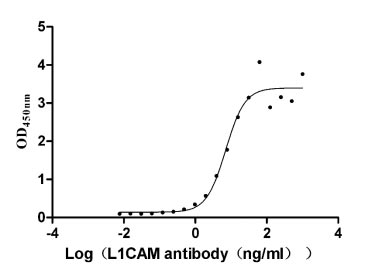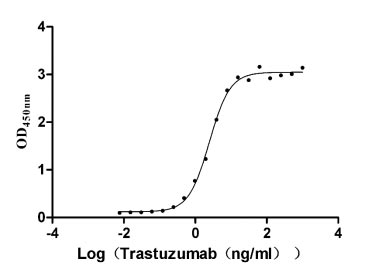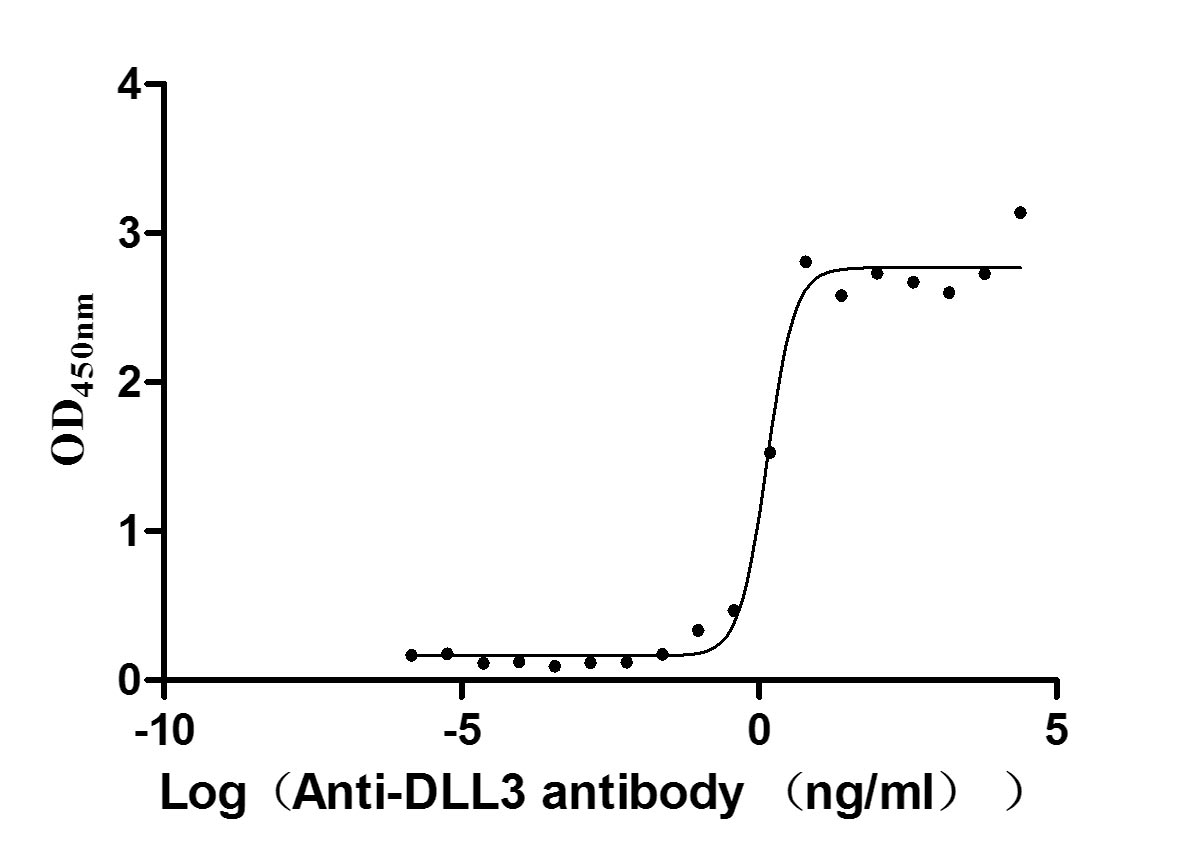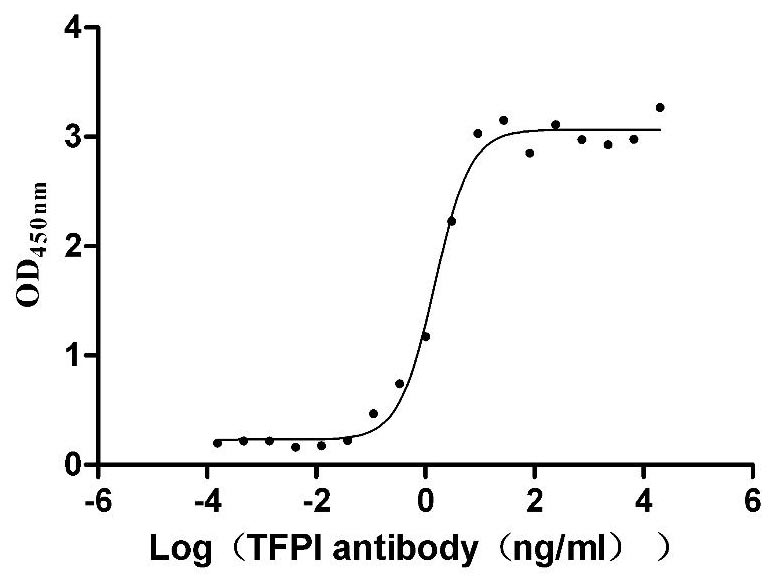Recombinant Mouse A-kinase anchor protein 5 (Akap5)
-
货号:CSB-YP001527MO
-
规格:
-
来源:Yeast
-
其他:
-
货号:CSB-EP001527MO
-
规格:
-
来源:E.coli
-
其他:
-
货号:CSB-EP001527MO-B
-
规格:
-
来源:E.coli
-
共轭:Avi-tag Biotinylated
E. coli biotin ligase (BirA) is highly specific in covalently attaching biotin to the 15 amino acid AviTag peptide. This recombinant protein was biotinylated in vivo by AviTag-BirA technology, which method is BriA catalyzes amide linkage between the biotin and the specific lysine of the AviTag.
-
其他:
-
货号:CSB-BP001527MO
-
规格:
-
来源:Baculovirus
-
其他:
-
货号:CSB-MP001527MO
-
规格:
-
来源:Mammalian cell
-
其他:
产品详情
-
纯度:>85% (SDS-PAGE)
-
基因名:Akap5
-
Uniprot No.:
-
别名:Akap5; Akap150; A-kinase anchor protein 5; AKAP-5; A-kinase anchor protein 150 kDa; AKAP 150; P150; cAMP-dependent protein kinase regulatory subunit II high affinity-binding protein
-
种属:Mus musculus (Mouse)
-
蛋白长度:full length protein
-
表达区域:1-745
-
氨基酸序列METSVSEIQV ETKDEKGPVA ASPQKERQER KTATLCFKRR KKANKTKPKA GSRTAEETKK HTPEAGGSGQ RQPAGAWASI KGLVTHRKRS EPAKKQKPPE AEVQPEDGAL PKKKAKSRLK FPCLRFSRGA KRSRHSKLTE DSGYVRVQGE ADDLEIKAQT QPDDQAIQAG STQGLQEGVL VRDGKKSQES HISNSVTSGE NVIAIELELE NKSSAIQMGT PELEKETKVI TEKPSVQTQR ASLLESSAAG SPRSVTSAAP PSPATTHQHS LEEPSNGIRE SAPSGKDDRR KTAAEEKKSG ETALGQAEEA AVGQADKRAL SQAGEATAGH PEEATVIQAE SQAKEGKLSQ AEETTVAQAK ETVLSQAKEG ELSQAKKATV GQAEEATIDH TEKVTVDQAE ETTVGQAEEA TVGQAGEAIL SQAKEATVVG QAEEATVDRA EEATVGQAEE ATVGHTEKVT VDQAEEATVG QAEEATVGQA EEATVDWAEK PTVGQAEEAT VGQAEEATVG HTEKVTVDQA EEATVGQAEE ATVGHTEKVT VDHAEEATVG QAEEATVGQA EKVTVDHAEE ATVGQAEEAT VGQAEKVTVD HAEEATVGQA EEATVGQAEK VTVDQAEEPT VDQAEEAISS HAPDLKENGI DTEKPRSEES KRMEPIAIII TDTEISEFDV KKSKNVPKQF LISMENEQVG VFANDSDFEG RTSEQYETLL IETASSLVKN AIELSVEQLV NEMVSEDNQI NTLFQ
-
蛋白标签:Tag type will be determined during the manufacturing process.
The tag type will be determined during production process. If you have specified tag type, please tell us and we will develop the specified tag preferentially. -
产品提供形式:Lyophilized powder
Note: We will preferentially ship the format that we have in stock, however, if you have any special requirement for the format, please remark your requirement when placing the order, we will prepare according to your demand. -
复溶:We recommend that this vial be briefly centrifuged prior to opening to bring the contents to the bottom. Please reconstitute protein in deionized sterile water to a concentration of 0.1-1.0 mg/mL.We recommend to add 5-50% of glycerol (final concentration) and aliquot for long-term storage at -20℃/-80℃. Our default final concentration of glycerol is 50%. Customers could use it as reference.
-
储存条件:Store at -20°C/-80°C upon receipt, aliquoting is necessary for mutiple use. Avoid repeated freeze-thaw cycles.
-
保质期:The shelf life is related to many factors, storage state, buffer ingredients, storage temperature and the stability of the protein itself.
Generally, the shelf life of liquid form is 6 months at -20°C/-80°C. The shelf life of lyophilized form is 12 months at -20°C/-80°C. -
货期:Delivery time may differ from different purchasing way or location, please kindly consult your local distributors for specific delivery time.Note: All of our proteins are default shipped with normal blue ice packs, if you request to ship with dry ice, please communicate with us in advance and extra fees will be charged.
-
注意事项:Repeated freezing and thawing is not recommended. Store working aliquots at 4°C for up to one week.
-
Datasheet :Please contact us to get it.
靶点详情
-
功能:Multivalent scaffold protein that anchors the cAMP-dependent protein kinase/PKA to cytoskeletal and/or organelle-associated proteins, targeting the signal carried by cAMP to specific intracellular effectors. Association with the beta2-adrenergic receptor (beta2-AR) not only regulates beta2-AR signaling pathway, but also the activation by PKA by switching off the beta2-AR signaling cascade. Plays a role in long term synaptic potentiation by regulating protein trafficking from the dendritic recycling endosomes to the plasma membrane and controlling both structural and functional plasticity at excitatory synapses.
-
基因功能参考文献:
- AKAP150 regulates Ca(2+ )cycling and myocardial ionotropy following pathological stress, promoting pathological remodelling and heart failure propensity. PMID: 27856611
- AKAP150-calcineurin signaling dyad is essential for the activation of the phosphatase and the subsequent down-regulation of Kv channel currents following myocardial infarction. PMID: 26724383
- This study demonstrated that the AKAP150 oordinates metabotropic glutamate receptor sensitization of peripheral sensory neurons. PMID: 26172554
- Thus, our present study revealed that AKAP5 plays a significant role in the regulation of sympathetic nerve activities. PMID: 26713362
- Identify a novel cardioprotective role for AKAP5 that is mediated by regulating the activities of cardiac CaN and CaMKII and highlight a significant role for cardiac beta-ARs in this phenomenon. PMID: 25225170
- endothelial-dependent dilation of resistance arteries is enabled by MEP-localized AKAP150, which ensures the proximity of PKC to TRPV4 channels and the coupled channel gating necessary for efficient communication from endothelial to smooth muscle cells PMID: 25005230
- Our results support a model whereby subcellular anchoring of CaN by AKAP150 is a key molecular determinant of vascular BKCa channel remodeling, which contributes to vasoconstriction during diabetes mellitus. PMID: 24323672
- a significant role for the AKAP5 scaffold in signaling and trafficking of the beta1-AR in cardiac myocytes and mammalian cells. PMID: 24121510
- Anchoring of protein kinase A and adenylyl cyclase by AKAP5 is important for regulation of postsynaptic functions and specifically AMPA receptor activity. PMID: 23649627
- AKAP150 null mice secrete less insulin yet have better glucose handling due to increased insulin sensitivity in target tissues. Tethering of phosphatases to a seven-residue sequence of Akap5 is the main molecular event for this. PMID: 22940692
- This study demonistrated taht AKAP79/150-anchored CaN in regulation of Ca2+-permeable GluA1 homomers that our results here now clearly establish as a key mechanism that maintains bidirectional synaptic plasticity in the hippocampus. PMID: 23100425
- A kinase anchor protein 150 (AKAP150)-associated protein kinase A limits dendritic spine density PMID: 21652711
- We propose that AKAP150-dependent changes in Ca(V)1.2-LQT8 channel gating may constitute a novel general mechanism for Ca(V)1.2-driven arrhythmias. PMID: 21700933
- other neural AKAPs cannot compensate for the loss of PKA binding to AKAP5 PMID: 20428246
- In knockout AKAP5 cardiomyocytes, beta-adrenergic regulation of calcium transients is disrupted. PMID: 20671242
- Study reveals that non-neurotransmitter Abeta has a binding capacity to beta(2)AR and induces PKA-dependent hyperactivity in AMPA receptors. PMID: 20395454
- These data suggest that isoproterenol-stimulated amylase secretion occurs via both an AKAP5/AC6/PKA complex and a PKA-independent, Epac pathway in mouse parotid acini. PMID: 20164376
- An important role of AKAP150 in coordinating signaling events regulating the frequency of intrinsic pulsatile GnRH secretion. PMID: 19887564
- CaMKIIalpha targets a specific SAP97 splice variant to disengage AKAP79/150 from regulating GluR1 AMPARs PMID: 19858198
- The association of AKAP150 with TREK channels integrates them into a postsynaptic scaffold where both G-protein-coupled membrane receptors and TREK-1 dock simultaneously. PMID: 17110924
- AKAP150 protein levels were increased upon exposing mice to the novel context independent of the training protocol. After habituation, only mice that learned to associate the context with the footshock showed an upregulation of AKAP150. PMID: 17270471
- AKAP150-anchored PKA might critically contribute to LTP in adult hippocampus in part by phosphorylating GluR1 to foster postsynaptic accumulation of homomeric GluR1 AMPA receptors during initial LTP in 8-week-old mice PMID: 17972919
- local control of L-type Ca2+ channel function is regulated by AKAP150-targeted protein kinase C signaling, which controls stuttering persistent Ca2+ influx, vascular tone, and blood pressure and underlies angiotensin II-dependent hypertension. PMID: 18174462
- temporal and spatial compartmentalization of hippocampal PKA signaling pathways, as achieved by anchoring of PKA to AKAPs, is specifically instrumental in long-term contextual fear memory consolidation and extinction, but not in acquisition and retrieval PMID: 18442935
- data indicate that AKAP150-anchored protein kinase A activity is required to induce long-term depression and not merely to maintain a tonically heightened activity level of AMPA receptors as proposed earlier PMID: 18617570
- distinct AKAP150-enzyme complexes regulate context-dependent neuronal signaling events PMID: 18711127
显示更多
收起更多
-
亚细胞定位:Postsynaptic recycling endosome membrane; Lipid-anchor.
-
数据库链接:
KEGG: mmu:238276
STRING: 10090.ENSMUSP00000114495
UniGene: Mm.311452
Most popular with customers
-
Recombinant Human Neural cell adhesion molecule L1 (L1CAM), partial (Active)
Express system: Mammalian cell
Species: Homo sapiens (Human)
-
Recombinant Human Receptor tyrosine-protein kinase erbB-2 (ERBB2), partial (Active)
Express system: Mammalian cell
Species: Homo sapiens (Human)
-
Recombinant Human Delta-like protein 3 (DLL3), partial (Active)
Express system: Mammalian cell
Species: Homo sapiens (Human)
-
Recombinant Human Insulin growth factor-like family member 1 (IGFL1) (Active)
Express system: Mammalian cell
Species: Homo sapiens (Human)
-
Recombinant Human Signal transducer CD24 (CD24)-Nanoparticle (Active)
Express system: Mammalian cell
Species: Homo sapiens (Human)
-
Recombinant Human Tissue factor pathway inhibitor (TFPI), partial (Active)
Express system: Mammalian cell
Species: Homo sapiens (Human)
-
Recombinant Human V-set and immunoglobulin domain-containing protein 4 (VSIG4), partial (Active)
Express system: Mammalian cell
Species: Homo sapiens (Human)
-
Recombinant Human Claudin-3 (CLDN3)-VLPs (Active)
Express system: Mammalian cell
Species: Homo sapiens (Human)




















